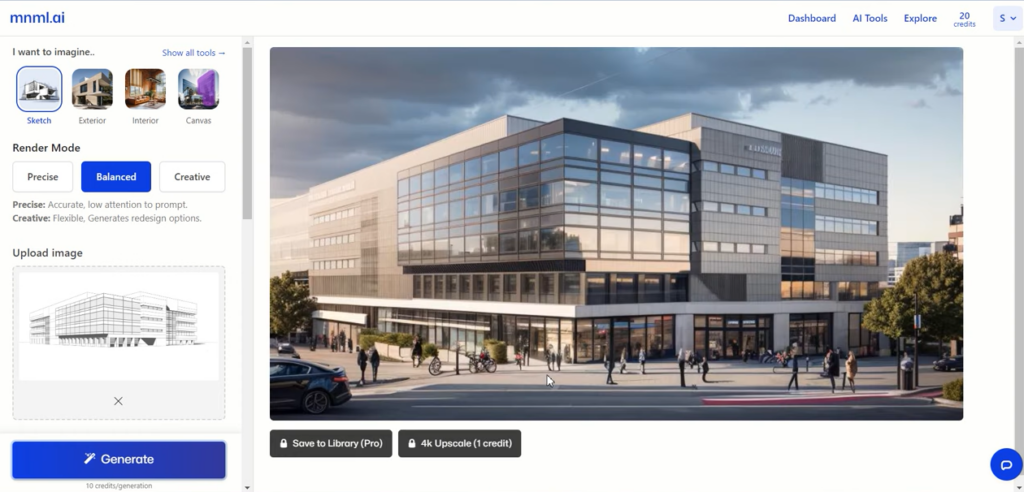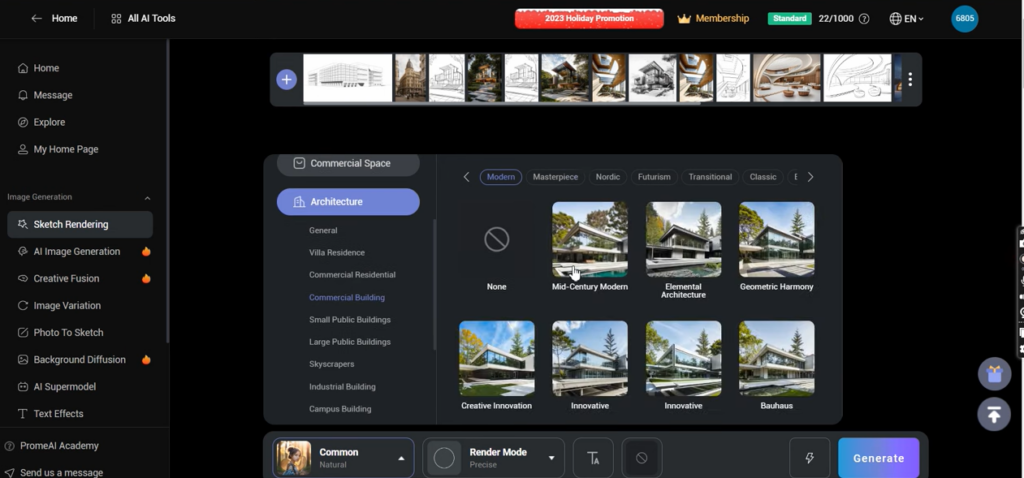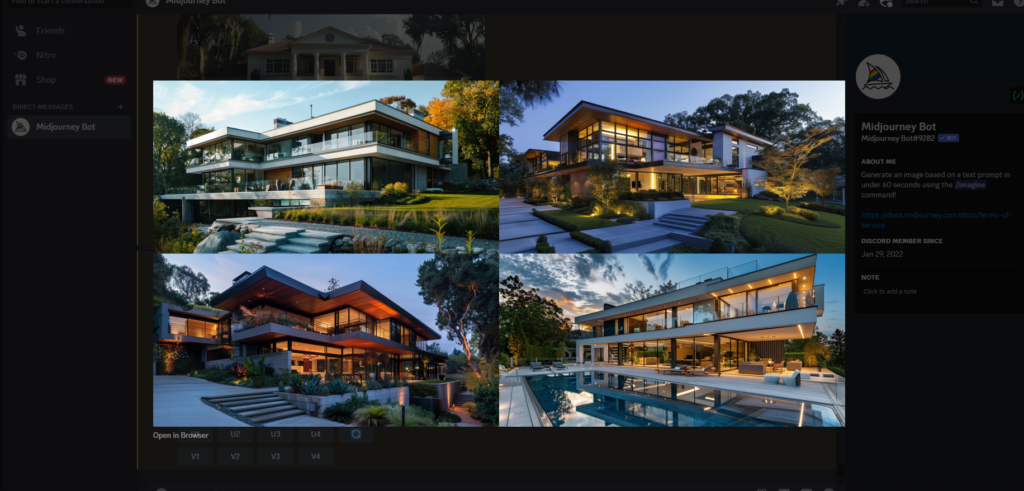In an era where the boundaries between the digital and physical worlds blur, architecture finds itself at a fascinating nexus of innovation. So what’s with Architect AI tools? Gone are the days of laborious hand-drawn sketches and the static nature of conventional CAD software. Welcome to the future—where Artificial Intelligence (AI) not only collaborates with architects but also inspires and elevates their creations to uncharted territories. This exciting convergence of technology and creativity heralds a new dawn in architectural design, one where imagination meets an almost unlimited potential for realization. As we stand on the precipice of this transformative era, let’s dive into the world of AI tools that are reshaping the architectural landscape, offering not just a glimpse into the future, but a detailed map to navigate it. Prepare to be amazed, inspired, and perhaps a little awestruck, as we explore the cutting-edge AI platforms setting the stage for the next architectural revolution.
As we embark on this exploration, let’s first glance at the standout performers in this exciting field:
- Fabrie AI – 8/10: Excelling in stylized renderings, ideal for vivid concept visualizations.
- ReRender AI – 5/10: Simple and straightforward, though lacking in detailed environmental interactions.
- mnml.ai – 8/10: Notably vibrant urban scene renderings, perfect for context-rich presentations.
- LookX AI – 7/10: Tailored for architects, focusing on materiality and lighting effects.
- PromeAI – 8/10: Versatility and detailed component creation make it a powerful ally for in-depth design explorations.
- Mid Journey – Specialized: A unique tool for conceptual exploration, prioritizing creativity over precision.
Join us as we delve deeper into each of these tools, uncovering how they can become integral components of the modern architect’s toolkit.
Fabrie AI
Fabrie AI stands out for architects interested in presenting their projects with a unique visual flair. Its strength in producing stylized renderings makes it particularly valuable for conceptual stages, where communicating the essence and atmosphere of a design is more important than detailed accuracy. Architects working in residential design or boutique commercial projects, where a distinctive visual narrative can attract clientele, will find Fabrie AI beneficial. Its high-volume output capability also supports architects in iterative design processes, allowing them to explore multiple visual directions quickly.
Site: https://www.fabrie.com

Pros
- User-Friendly Interface: Offers an intuitive and easy-to-navigate platform suitable for both professionals and hobbyists.
- High Volume Output: Allows the generation of 300 images per day, catering to users with high-volume rendering needs.
- Stylized Renderings: Excels in creating visually distinctive and stylized architectural visuals that stand out.
Cons
- Limited Environmental Detail: While it renders buildings well, the detail in the surrounding environments is lacking.
- Niche Appeal: The stylization might not suit all projects, especially those requiring hyper-realistic visuals.
- Platform Awareness: Being lesser-known might deter some users from discovering its capabilities.
Described as an underrated canvas for creating not just architectural renderings but also images, articles, and sketches. It allows for a high volume of image outputs per day and offers various rendering styles. We appreciate its stylization and rate it 8 out of 10.
Ease of Use
Fabrie AI presents a user-friendly interface, catering not solely to professionals in architecture but also to others involved in creative endeavors. Of the Architect AI tools reviewed, its canvas allows users to effortlessly navigate through different functionalities, such as image creation and article writing. The process of rendering involves simple steps – selecting a category, uploading the base image, and choosing the rendering style, making it accessible for beginners and experienced users alike.
Output Quality
The platform excels in producing stylized renderings that appeal to users looking for a distinct visual flair in their architectural presentations. The output quality, rated 8 out of 10, suggests a high level of detail and aesthetic appeal, particularly in the expression of surfaces and materials. However, while it renders the structures impressively, the environment around the architectural models may not exhibit the same level of detail or complexity, which could be a consideration for users requiring comprehensive environmental integration.
ReRender AI
For architects seeking a straightforward, no-frills tool for quick conceptual visualizations, ReRender AI offers a practical solution. Its simplicity and ease of use make it suitable for early-stage design exploration, especially when time or resources are limited. Although the environmental detailing may fall short, it can still be a valuable asset for solo practitioners or small firms that need to generate simple visuals without investing heavily in more complex software or extensive training.
Site: https://rerenderai.com

Pros
- Simplicity in Use: The straightforward interface and predefined styles make it easy for beginners.
- Quick Selection Process: The platform speeds up the rendering process with its set of predefined styles.
- Focused Rendering Options: Offers typologies of buildings for more targeted rendering outputs.
Cons
- Poor Environmental Rendering: Fails to generate convincing environments around the architectural model.
- Basic Output Quality: The overall quality of renders may not meet the standards of more detailed architectural needs.
- Limited Free Plan: The restrictive free plan may not be sufficient for users with regular rendering needs.
Of the Architecture AI tools reviewed, its marked by its simplicity, this platform provides a straightforward interface for rendering with predefined styles. However, the output was considered unsatisfactory due to the lack of an environment around the building, leading to a rating of 5 out of 10.
Ease of Use
ReRender AI focuses on simplicity, offering a streamlined process for uploading images and selecting styles. Its minimalistic approach is beneficial for users seeking a no-frills rendering tool. The platform provides predefined style sets and typologies, enabling quick selections without the need for extensive customization.
Output Quality
The platform falls short in terms of rendering detailed environments, resulting in outputs where the surrounding landscape appears flat and uninvolved. This limitation is noticeable in the lack of trees, roads, and background elements, contributing to a rendering that feels isolated. Rated at 5 out of 10, the output quality might suit basic architectural visualization needs but lacks the depth and realism required for more advanced or commercial presentations.
mnml.ai
mnml.ai is well-suited for architects aiming to embed their designs within vibrant, lifelike urban scenes. The platform is most valuable during the presentation or competition phases of a project, where engaging and dynamic visuals can significantly impact communication with clients, stakeholders, or jurors. Especially for urban planning and landscape architecture, where the interaction between the built environment and its context is crucial, mnml.ai capacity to render detailed surroundings makes it an indispensable tool.\
Site: https://mnml.ai

Pros
- Rich Urban Scenes: Generates vibrant and detailed renderings that encompass lively urban environments.
- Additional Features: Beyond rendering, offers a suite of tools for creative image manipulation.
- High-Quality Outputs: Delivers high-quality renderings that accurately depict both architecture and its surroundings.
Cons
- Learning Curve: The range of features might overwhelm new users, requiring some time to fully utilize the platform.
- Subscription for Best Features: The most compelling features may be gated behind a subscription model.
- Potential Overemphasis on Vibrancy: The vibrant color schemes might not always align with the desired aesthetic of every project.
Of the Architect AI tools reviewed, similar to other platforms but noted for high-quality render outputs and additional features beyond rendering. The platform surprisingly produced lively and vibrant urban scenes, achieving an 8 out of 10 rating.
Ease of Use
mnml.ai offers an interface that balances simplicity with a range of features beyond mere rendering, such as sketch to image conversions. Users can easily navigate its offerings and make use of additional functionalities, which extend the platform’s utility beyond typical architectural rendering tools.
Output Quality
The platform demonstrates a remarkable ability to render vibrant urban scenes that breathe life into architectural models. Rated 8 out of 10, the output quality is noted for its lively colors and dynamic compositions, including detailed environments with roads, cars, and trees. This level of detail in both the architecture and its surroundings makes mnml.ai a compelling choice for those looking to present their models within rich, engaging settings.
LookX AI
LookX AI is explicitly tailored for architectural use, making it ideal for professionals seeking detailed and realistic visualizations with an emphasis on materiality and lighting. Its architectural focus means that the tools and workflows are designed to align closely with professional needs, including detailed input modes that accommodate various architectural visualization requirements. Architects working on high-end residential, commercial, or cultural projects where the precise representation of materials and light plays a critical role in client presentations and approvals will find LookX AI immensely beneficial.
SIte: https://www.lookx.ai

Pros
- Architectural Focus: Designed specifically for architects, offering tools and options tailored to professional needs.
- Dynamic Lighting Effects: Excels in rendering with emphasis on lighting and material effects.
- Comprehensive Input Modes: Supports various input modes tailored to specific architectural visualization demands.
Cons
- Steeper Learning Curve: The specialized interface may require additional learning time for non-professionals.
- Environment Detailing: While competent, sometimes lacks the full realism in the environmental setup.
- Potentially Overwhelming Options: The breadth of architectural-focused features may intimidate newer users.
Of the Architecture AI tools reviewed, this is touted as the first AI platform designed by architects for architects. Despite having a detailed approach and interesting light effects, the final renderings were rated 7 out of 10 for their similarity to previously reviewed platforms and their dynamic environment integration.
Ease of Use
LookX AI distinguishes itself with a focus on architectural rendering, designed by architects, for architects. This specialization is reflected in its user interface, which, while comprehensive, may present a steeper learning curve for those outside the architectural profession. The tool offers various input modes tailored to specific types of architectural visualization.
Output Quality
With a rating of 7 out of 10, LookX AI produces quality renderings with notable lighting effects and material details. However, while the platform competently addresses the rendering of the architecture itself, the generated environments, despite being dynamic, can occasionally lack the full realism and detail seen in some competing platforms.
PromeAI
PromeAI offers versatility and detailed component creation, making it ideal for architects engaged in complex projects that require finely tuned visual representations. The platform’s wide array of styles and rendering modes allows for experimentation with different architectural aesthetics, from historical renovations requiring a sensitive approach to modern, minimalistic designs calling for crisp, clean lines. It’s particularly valuable for interior design and detailed facade studies, where the materials’ texture and interplay with light are pivotal. Architects looking to explore iterative design options with a focus on materiality and detail will appreciate what PromeAI has to offer.
Site: https://www.promeai.com

Pros
- Flexibility and Functions: Offers a vast array of styles and rendering modes for maximum creative expression.
- Detailed Component Creation: Exceptional at rendering detailed individual components like window frames and glasses.
- Versatility: Useful for a broad audience, from architects to artists, thanks to its varied functionalities.
Cons
- Complexity for New Users: The array of options and functionalities might overwhelm beginners.
- Life and Activity in Scenes: Scenes sometimes lack vibrancy in terms of populated life and activities.
- Balance Between Detail and Performance: High detail in architecture can come at the expense of rendering speed or intuitiveness for some users.
Of the Architecture AI tools reviewed, this one is popular among architects and artists for its flexibility and extensive functions. It’s noted for its detailed individual component creation and its overall environment, although lacking some vibrancy in life scenes. It earned an 8 out of 10 rating.
Ease of Use
PromeAI stands out for its versatility and wide range of functions, appealing to a broad spectrum of users from architects to artists. The platform offers various styles and rendering modes, facilitating creative flexibility. However, the abundance of options might require a period of acclimatization for new users to fully exploit its capabilities.
Output Quality
The output from PromeAI is detailed, earning it an 8 out of 10 rating. The renderings are commendable for their material specificity and depth, particularly in elements like window frames and glass. Nevertheless, while the architectural models are rendered with significant detail, the platform’s ability to populate the scene with vibrant life and activity could be improved to enhance the realism of the environmental context.
Mid Journey
For architects focused on the conceptual and schematic design phases, Mid Journey offers an unparalleled tool for creative exploration. It introduces a novel approach to architectural visualization, prioritizing conceptual richness and imaginative exploration over technical precision. This makes it especially valuable for conceptual design phases, competitions, and early client presentations, where the goal is to convey innovative ideas and evoke emotional responses rather than deliver technically accurate representations. Architects seeking to push the boundaries of design through AI-driven inspiration will find Mid Journey an exciting companion in their creative process.
Site: https://www.midjourney.com

Pros
- Conceptual Exploration: Excellent for exploring architectural concepts and stimulating creative thinking.
- Non-Traditional Rendering Approach: Offers a unique perspective by focusing on conceptual rather than accurate representations.
- Personalized Prompts: Allows users to guide the AI’s creative process with prompts, providing a personalized experience.
Cons
- Not for Precise Renders: Not ideal for projects requiring accurate and detailed architectural renders.
- Adaptation Period: Users accustomed to traditional rendering tools may need time to adapt to its conceptual focus.
- Limited Environmental Integration: While great for conceptualization, it may not generate detailed environments around models effectively.
Of the Architecture AI tools reviewed, this AI platform does not directly create accurate architectural renderings from SketchUp models but is more utilized for conceptual exploration. The discussion with architect Samir highlights its application as more of a creative tool rather than a direct rendering solution.
Ease of Use
Mid Journey, unlike the other platforms, is not a straightforward rendering tool but more of a conceptual exploration aid for architects. Its usage involves a distinctive approach where the architect provides prompts to guide the AI, which might require a learning period for those accustomed to conventional rendering tools.
Output Quality
Mid Journey’s strength lies in its conceptual visualization rather than accurate architectural rendering. As such, it might not produce the precise details or definitive environments associated with typical architectural models. However, for the purpose of exploring conceptual designs and stimulating creative architectural thinking, Mid Journey offers a unique and valuable perspective, albeit with a different focus from traditional rendering tools.
Architects AI Tools Summary
As we navigate through the rapidly evolving landscape of architectural design, the advent of Artificial Intelligence (AI) tools has opened up new horizons of creativity and efficiency. From conceptual sketches to highly detailed environmental renderings, AI-based platforms are transforming the way architects visualize and communicate their ideas. But with a plethora of options available, how do architects discern which tools best align with their specific needs? In response to this question, we’ve curated a comprehensive overview of six cutting-edge AI tools that are making significant strides in the industry. Below, you’ll find a meticulously crafted table delineating the standout features of each tool, offering insights into their unique value propositions tailored to various aspects of architectural practice. This exploration seeks to illuminate the pathways through which AI can amplify the architectural imagination, pushing the boundaries of what’s possible in design representation and beyond.
| AI Tool | Best Features | Why It’s of Value to Architects |
|---|---|---|
| Fabrie AI | User-Friendly Interface High Volume Output Stylized Renderings | Allows architects to rapidly prototype and experiment with unique visual styles, making it excellent for initial concept presentations. |
| ReRender AI | Simplicity in Use Quick Selection Process Basic Rendering Options | Ideal for straightforward, early-stage visualization needs, especially when simplistic representations are sufficient. |
| mnml.ai | Rich Urban Scenes High-Quality Outputs Varied Creative Features | Enhances presentation quality with vibrant and detailed urban scenarios, beneficial for projects within bustling contexts. |
| LookX AI | Architectural Focus Dynamic Lighting Effects Detailed Input Modes | Provides sophisticated visualization capabilities for intricate designs, emphasizing material and lighting fidelity. |
| PromeAI | Versatility and Functionality Detailed Component Creation Wide Array of Styles | Supports detailed design exploration and presentation, facilitating a deeper exploration of materials and environments. |
| Mid Journey | Conceptual Exploration Non-Traditional Rendering Personalized Prompt Interpretation | Encourages innovative design thinking and ideation beyond conventional boundaries, opening new avenues for architectural creativity. |
Wrap Up
In conclusion, the landscape of architectural visualization is undergoing a remarkable transformation, fueled by the advancement of Artificial Intelligence (AI) tools. Each platform discussed herein—Fabrie AI, ReRender AI, mnml.ai, LookX AI, PromeAI, and Mid Journey—offers unique capabilities and benefits tailored to different stages and aspects of architectural practice. From early conceptual sketches to detailed environmental renderings, these AI tools are expanding the possibilities for architects to communicate their visions more effectively and creatively.
However, it’s important to recognize that this field is in a state of rapid evolution, with new tools and technologies constantly under development. The platforms reviewed in this article represent just a snapshot of the current offerings available to architects. As AI technology continues to evolve, we can anticipate the emergence of even more sophisticated tools designed to meet the specific needs of architectural visualization.
Therefore, architects and design professionals should keep a keen eye on this space over the coming months. Staying informed about new developments and emerging tools will not only enhance your practice but also ensure that you remain at the forefront of design and visualization technologies. The integration of AI in architecture is just beginning, and its future promises to bring even more groundbreaking tools and methodologies for the creation, exploration, and presentation of architectural designs.

Leave a Reply